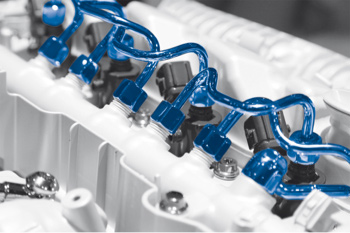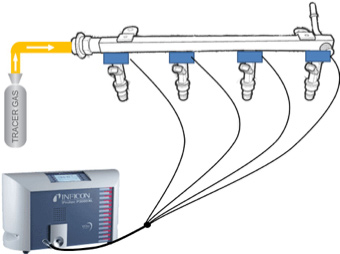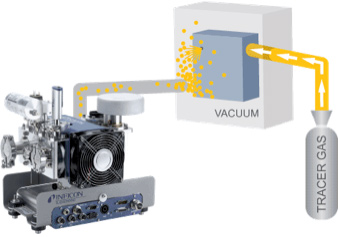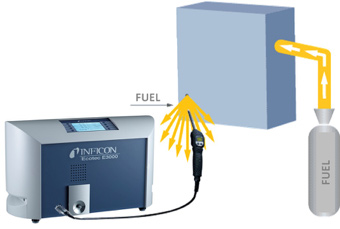Leak Testing of Fuel Rails
Description of Technical Challenge
 The need for lower fuel consumption drives the need for high pressure fuel injection. Injection pressures have significantly increased over the past few years. Today injection pressures can reach up to 2,000 bar (~ 150,000 psi). Fuel leaks can negatively influence fuel consumption and could cause a fire in the engine compartment. With increasing fuel injection pressures, larger leak rates will be generated by the same size leak hole.
The need for lower fuel consumption drives the need for high pressure fuel injection. Injection pressures have significantly increased over the past few years. Today injection pressures can reach up to 2,000 bar (~ 150,000 psi). Fuel leaks can negatively influence fuel consumption and could cause a fire in the engine compartment. With increasing fuel injection pressures, larger leak rates will be generated by the same size leak hole.
To prevent leakage, fuel rails need to be tested for leaks during component production at supplier level. Often the complete subassembly of the fuel rail with fuel injectors is tested. Later in the production process, connections from the fuel rail to other components (like the high pressure fuel pump or the sealing of the fuel injector / fuel rail assembly against the engine block) need to be tested after final assembly.
Maximum allowable leak rates usually range in the 10-4 mbar l/s range.
The INFICON Solution
Leak testing in component production
| Clam Shell Testing | Vacuum chamber testing | |
|---|---|---|
| Throughput | Medium | High |
| Investment | Medium | High |
| Integral / Localizing | Localizing Method | Integral method, leak needs to be localized later |
Comparison of leak testing methods for component production
 In a clam shell system, small clamps are placed around the connectors to be tested. The fuel rail is then evacuated and pressurized with helium. If the connection is leaky, the helium concentration inside the clam shell will increase. The Protec P3000(XL) Helium Leak Detector is then connected to the clams and draws a sample from the inner volume of the clam shell. If helium is present in the sample, it is then detected by the Wise Technology helium sensor inside the Protec P3000(XL). The high flow of the Protec P3000(XL) offers some unique benefit for clam shell testing as its high flow allows for all clam shells to be tested simultaneously. Only when a leak is detected will the test system sequence through the individual clams and locate which connection is leaking.
In a clam shell system, small clamps are placed around the connectors to be tested. The fuel rail is then evacuated and pressurized with helium. If the connection is leaky, the helium concentration inside the clam shell will increase. The Protec P3000(XL) Helium Leak Detector is then connected to the clams and draws a sample from the inner volume of the clam shell. If helium is present in the sample, it is then detected by the Wise Technology helium sensor inside the Protec P3000(XL). The high flow of the Protec P3000(XL) offers some unique benefit for clam shell testing as its high flow allows for all clam shells to be tested simultaneously. Only when a leak is detected will the test system sequence through the individual clams and locate which connection is leaking.
 For higher throughput, the complete subassembly can be tested in a vacuum chamber. For this testing process, the fuel rail is sealed before large vacuum pumps pull a vacuum once the chamber lid is closed. The fuel rail and chamber are evacuated simultaneously; subsequently the fuel rail is backfilled with helium. Helium then has the opportunity to migrate outwards and if a leak is present, the INFICON LDS3000 Helium Leak Detector (which is valved into the vacuum pumps after the part has been filled with helium) detects the helium atoms as they emerge from the fuel rail.
For higher throughput, the complete subassembly can be tested in a vacuum chamber. For this testing process, the fuel rail is sealed before large vacuum pumps pull a vacuum once the chamber lid is closed. The fuel rail and chamber are evacuated simultaneously; subsequently the fuel rail is backfilled with helium. Helium then has the opportunity to migrate outwards and if a leak is present, the INFICON LDS3000 Helium Leak Detector (which is valved into the vacuum pumps after the part has been filled with helium) detects the helium atoms as they emerge from the fuel rail.
With this testing method, however, an additional testing step is required to locate the leaks in faulty subassemblies for subsequent repair.
Leak testing in final assembly
 After final assembly of the fuel rail system, the connectors from the fuel rail subassembly to other components (like the high pressure fuel pump or the sealing of the fuel injector / fuel rail assembly against the engine block) need to be tested. After filling with fuel and running the engine at least once – so that the fuel rail system is pressurized with fuel – the connections will be checked for leaks by sniffing with the Ecotec E3000 Multi-Gas Leak Detector.
After final assembly of the fuel rail system, the connectors from the fuel rail subassembly to other components (like the high pressure fuel pump or the sealing of the fuel injector / fuel rail assembly against the engine block) need to be tested. After filling with fuel and running the engine at least once – so that the fuel rail system is pressurized with fuel – the connections will be checked for leaks by sniffing with the Ecotec E3000 Multi-Gas Leak Detector.
The Ecotec E3000 can detect any gaseous substance selectively including gasoline and diesel. For leak testing, the sniffer tip of the Ecotec 3000 is placed on the connectors to be tested. In case of a leak, the escaping gasoline or diesel is transported to the sensor system inside the Ecotec E3000 by the flow through the sniffer line and the leak is detected.
TIP:
Ecotec E3000 can also be used in the same testing step to check the air conditioning system for leaks by setting it up to detect fuel and refrigerant simultaneously.
Benefits of Leak Testing Fuel Rails with Tracer Gas
- Accurate and repeatable measurements for reliable results of leak testing
- High sensitivity leak testing to find the smallest leaks
- Multi-step process to detect leaks early in the production process
For more information, please visit us at www.inficonautomotive.com